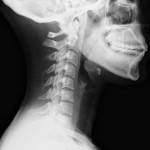
[This is the first MSK Elf blog from colleagues at the Primary Care Rheumatology Society, who will be contributing more to the website in future. We warmly welcome Tom, Mike, Jean, Christine, Adrian and colleagues to the woodland! You can read more about our partnership here.]
Whiplash and neck pain are common conditions, which impose a large economic burden on the NHS, as well as society as a whole in terms of lost productivity. Many treatment modalities are available but the ideal, most cost effective treatment has yet to be found. Health resource use remains high so guideline developers and health economists need good quality evidence on which to base their recommendations.
A previous systematic review in 2008 identified only three studies providing economic evaluations (Hurwitz et al, 2008). Here in the woodland, the Elves were excited to hear of a new and updated systematic review, which promised to deliver additional evidence.

Whiplash claims are said to cost the UK insurance industry approximately £2 billion each year.
Methods
This was a systematic review carried out in accordance with the Cochrane Handbook for Systematic Reviews of Interventions and the PRISMA statement, an evidence based protocol for systematic reviews. The paper was produced by a group from the University of Toronto, Ontario and published in the Spine Journal (van der Velde et al, 2015).
The researchers carried out exhaustive searches of the available literature from 2000-2013, on CINAHL, Cochrane economic databases (Health Technology Assessment, NHS Economic Evaluation Database), EconLit, EMBASE, MEDLINE, PsycINFO, and Tufts CEA Registry from 2000 to 2015. It included the previous 2008 systematic review by the Bone and Joint Decade 2000-2010 Task Force on Neck Pain and its Associated Disorders (NPTF) (Hurwitz et al, 2008).
Evidence was evaluated using the Scottish Intercollegiate Guidelines Network (SIGN) Methodology Criteria. Further analysis was then done on those studies, which met the criteria, looking at quality-adjusted life years (QALYs), and cost effectiveness based on a standardised currency of ‘willingness-to-pay’ per additional QALY gained.
Results
Six studies met the eligibility criteria; the first three of which were previously included in the NPTF’s 2008 review of non-invasive interventions. Here is a summary of their main findings:
- Persistent neck pain
- Acupuncture added to routine multimodal care was found to be almost certainly (99.7%) cost effective.
- Variable duration neck pain
- Multimodal care was not cost effective compared to CBT (cognitive behavioural therapy) alone by physiotherapists
- Manual therapy was cost-effective, appearing to be less costly and more effective than multimodal physiotherapy, which in turn was less costly and more effective than multimodal GP care
- Advice and exercise alone was found to be less costly and more effective than advice and exercise combined with either pulsed short wave diathermy or manual therapy
- Acute whiplash (grade I-III, <6 weeks)
- Routine education (oral advice/leaflet) was less costly and more effective than ‘Active management’ (reassurance and advice to maintain normal activities/exercise, analgesic use, collar avoidance, and The Whiplash Booklet
- For those with substantial symptoms at 3/52, single education session was less costly/more effective than multimodal physiotherapy care
- Recent onset neck pain
- Multimodal care (manual therapy and exercise) was less costly and more effective than psychological intervention.

The review found that structured education was cost-effective for whiplash and associated disorders.
Conclusions
Our review adds to the findings of the NPTF [Task Force on Neck Pain and its Associated Disorders]. Recent evidence suggests that structured education is cost-effective for WAD [Whiplash associated disorders], while advice and exercise and multimodal care that includes manual therapy are cost-effective for NAD [Neck pain and associated disorders].
Obtaining more robust health economic evidence for non-invasive interventions for WAD and NAD in children and adults remains an essential research priority.
Strengths and limitations
This systematic review was conducted with a rigorous approach and methodology, to try to eliminate bias and select only the most relevant, high quality studies. As such it perhaps offers some of the most valid evidence in this area.
However, there are clear difficulties in interpreting data drawn from such different health care settings, with so many complex variables in study population, design and methodology. Only 6 studies met the eligibility criteria and three of these acknowledge concerns over statistical significance. Some apparently significant results appear contradictory also; for example the cost effectiveness or otherwise of manual and psychological therapies combined in different treatment modalities, between different studies.
It is worth noting that the differences in outcomes between the various interventions in terms of QALYs gained were relatively small, whilst total costs of treatments ranged widely, and had a significant impact on cost effectiveness overall. Under these rules a cheap treatment with low effectiveness will likely outperform effective but more expensive treatments. Until such reviews take into account the far-reaching societal cost savings in preventing chronic pain and disability, these economic arguments may be thought somewhat incomplete.
Interpretation of this ‘best evidence’ therefore needs to be viewed with caution, a point noted by the authors themselves, who highlighted the need for more robust health economic evidence as an essential further research priority.
The Musculoskeletal Elf’s view

So how should the Elves consider this evidence, and its impact on current practice?
A pragmatic approach, given the relatively small differences in outcomes between interventions, would seem to be to keep it simple and low cost for the majority of our patients, using good quality advice and education alone at first, with multimodal care that includes manual therapy added in for more persisting or complex cases.
The Elves think that this approach agrees with current best practice guidelines using available resources within the UK Primary Care setting.
The cost effectiveness of acupuncture for persisting neck pain is interesting, since this intervention is not readily available on the NHS in many areas, except through costly pain clinics; an increasing extended role for physiotherapists in the future potentially.
The Elves noticed that litigation wasn’t discussed in the review; an ongoing personal injury claim delays recovery from whiplash (Sterling et al, 2010). The Chancellor unveiled measures to curb insurance claims for whiplash injury in the 2015 autumn statement. Do you think this will have an impact on the prevalence of chronic neck pain?

Use good quality advice and education alone at first, with multimodal care that includes manual therapy added in for more persisting or complex cases.
Links
Primary paper
van der Velde G, Yu H, Paulden M, Côté P, Varatharajan S, Shearer HM, Wong JJ, Randhawa K, Southerst D, Mior S, Sutton D, Jacobs C, Taylor-Vaisey A. (2015) Which interventions are cost-effective for the management of whiplash-associated and neck pain-associated disorders? A systematic review of the health economic literature by the Ontario Protocol for Traffic Injury Management (OPTIMa) Collaboration. Spine Journal. 2015 Nov 26. pii: S1529-9430(15)01235-8. doi: 10.1016/j.spinee.2015.08.025. [PubMed abstract]
Other references
Hurwitz EL, Carragee EJ, van der Velde G, Carroll LJ, Nordin M, Guzman J, Peloso PM, Holm LW, Côté P, Hogg-Johnson S, Cassidy JD, Haldeman S; Bone and Joint Decade 2000-2010 Task Force on Neck Pain and Its Associated Disorders. (2008) Treatment of neck pain: noninvasive interventions: results of the Bone and Joint Decade 2000-2010 Task Force on Neck Pain and Its Associated Disorders. Spine (Phila Pa 1976). 2008 Feb 15;33(4 Suppl):S123-52. doi: 10.1097/BRS.0b013e3181644b1d. [PubMed abstract]
Sterling M, Hendrikz J, Kenardy J. (2010) Compensation claim lodgement and health outcome developmental trajectories following whiplash injury: A prospective study. Pain. 2010 Jul;150(1):22-8. doi: 10.1016/j.pain.2010.02.013. Epub 2010 Mar 21. [PubMed abstract]
Photo credits

Whiplash and neck pain: what’s most cost-effective? https://t.co/9tfr50VCIo
Welcome to the woodland! Two of our new GP bloggers Tom Rowley & Michael Horsfield from @pcrsociety https://t.co/9tfr50VCIo
Whiplash claims are said to cost the UK insurance industry approximately £2 billion each year https://t.co/9tfr50VCIo
Whiplash and neck pain: what’s most cost-effective? https://t.co/eao1wodlS3 https://t.co/AEzTT3SkX1
Whiplash and neck pain: what’s most cost-effective? @MSK_Elf looks at the evidence https://t.co/VnsXQ3iSlW
Systematic review finds that structured education was cost-effective for whiplash & associated disorders https://t.co/9tfr50VCIo
Don’t miss – Whiplash and neck pain: what’s most cost-effective? https://t.co/9tfr50VCIo #EBP
I am unsure how acupuncture added to multi-modal care can be stated to be 99.7% cost effective when there is little good evidence that it is effective for anything (beyond placebo effect), and it is costly.
First I like this post and that someone has taken the time to sift through to find answers for this condition because just going through the what works can save people misery and pain. It is well written and researched here especially considering what is available. WE need to do better on clear evidence based diagnosis. The challenge is ignorance with this one size fits all diagnosis with vague non evidence based grades, It would please me if they abolished this catch all phrase. It covers over very serious injury, for example I had an initial DX of whiplash. However my neck was broken, my sternum was cracked and a rib was pushed into my heart plus there were other internal injuries and brain injury . Because they were fixated on this “treatment” and looked but failed to see the radiographic evidence that was there from the beginning, I was untreated for 9 months. Others are vastly over treated at horrendous cost with little effect. It both too much and too little medicine.
Amy, you are right to point out that the diagnostic labels of whiplash and neck pain associated disorders are non-specific. Heterogeneous conditions are notoriously difficult to subject to good quality trials. Furthermore, imaging correlates very poorly with symptoms, further challenging creating objective inclusion criteria. Many clinical conditions don’t neatly fit into a diagnostic box, so evidence must be interpreted with that in mind.
Caroline, thanks for your comment. I agree with your statements about the the existing evidence base and associated costs of acupuncture, thoroughly summarised in Singh/Ernst ‘Trick or Treatment’. I share your surprise at the findings in the review. Our blog summarises the systematic review paper and although it would be very interesting to look in more detail at the individual papers, it was beyond the scope of our article.
This also rather conflicts with the new NICE guidelines on Low back pain shortly to be released. In our ‘Strengths and Limitations’ section, we comment on the difficulties in interpreting data with so many complex variables. Impact of individual therapists and the ‘Placebo’ effect is significant in most of these treatment modalities also (and should this be readily dismissed even?!). Clearly even the most apparently well designed studies need to be interpreted with a degree of caution and skepticism
[…] 1Whiplash and neck pain: what's most cost-effective? The Musculoskeletal Elf […]
The Elves noticed that litigation wasn’t discussed in the review; an ongoing personal injury claim delays recovery from whiplash (Sterling et al, 2010). The Chancellor unveiled measures to curb insurance claims for whiplash injury in the 2015 autumn statement. Do you think this will have an impact on the prevalence of chronic neck pain? – It is always good to become very aware of vested interests in these situations and how they affect treatment. HINT it is not the patients they only want to be well and they do not see most compensation it all goes up in medical treatment and legal fees plus it is stressful and takes away from what needs to be the focus and that is full recovery. Curbing claims is whipping the victims, why not have an agreed package & if this is not effective a new indepth DX with evidence informed effective interventions again time limited and with realistic outcomes.
Amy, thanks again for the comment. You raise an interesting point about the ‘claim culture’ driving a medico-legal industry without necessarily providing benefit to the victim. I agree with your thoughts that the legal process “takes away from what needs to be the focus”; the constant reminders, alarming imaging reports and medicals might just be a significant modulator of the pain response? See http://www.bodyinmind.org Let’s hope that the simplified system creates space to receive early positive messages and appropriate reassurance while avoiding the unnecessary, potentially harmful medicalisation and imaging.
Please do not dismiss accupuncture’s evidence base, it may be weak and placebo effects strong, but here is some evidence for acupuncture in neck pain specifically: http://aim.bmj.com/content/acupmed/22/3/146.full.pdf. Acupuncture does not appear to be the same “evidence free zone” which surrounds homeopathy for example.
I would be interested to know the current state of opinion on the effect of litigation on whiplash outcomes. I know that there has been extensive research, but I’ve not found a convincing meta-analysis or definitive study, is anybody here aware of one?